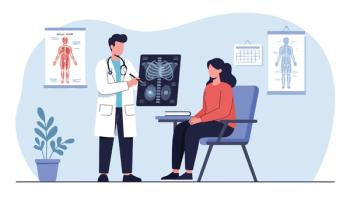
- Financial Assistance
- Volume 2
- Issue 1
Financial Lifelines
Charitable organizations offer help to patients who are struggling.
For most people in their 20s, life stretches out before them like an endless highway, full of possibilities. Andrew Ladd and Fumiko Chino were no different, busy planning a life together as he worked toward a doctorate in robotics at Rice University and she pursued a career as an art director. But when Ladd fell ill in 2005 and was diagnosed with a particularly aggressive form of neuroendocrine carcinoma, their lives changed in an instant.
In addition to dealing with the stress of a cancer diagnosis, Chino says, the financial aspects of her husband’s illness (the couple married in 2006) soon became an oppressive hardship. “We quickly realized he was horribly underinsured,” she remembers. “We were hit with an enormous burden of out-of-pocket expenses that really crushed our spirits and affected our quality of life.”
As Ladd’s disease progressed, Chino was forced to quit her job to care for him. The couple eventually exhausted their savings and reached the limits of their insurance coverage.
When her husband died in 2007, she was left with a mountain of unpaid bills. “Before this, I had felt I was in charge of my life, and suddenly I was $300,000 in debt,” Chino says. “I had never even been in debt before this happened.”
A GROWING PROBLEM
What the couple experienced now has a name: financial toxicity. The term, coined by Yousuf Zafar, M.D., M.H.S., a cancer researcher at Duke University School of Medicine, refers to the financial harm that often results due to a severe or extended illness. Chino’s personal experience with toxic debt motivated her to return to academia at Duke and become a radiation oncologist. She now works beside Zafar, helping others through their own battles with cancer and its aftereffects.
It’s no mystery why so many patients with cancer experience unprecedented levels of debt, even if they have insurance: The cost of treatment and medications is at an all-time high. According to the Journal of Oncology Practice, 12 of 13 cancer drugs arriving on the market in 2012 cost more than $100,000 per year. For a patient whose share after insurance comes to the typical 20 to 30 percent, the annual bill would be $20,000 to $30,000 — almost half the average American’s yearly income.
The results of a recent study showed that patients with cancer are 2.6 times more likely to go bankrupt than those without cancer.
“Cancer treatments are some of the most expensive in the industry,” Zafar says. “Medical bills are thought to be the most common cause of bankruptcy in the United States.
“Taking those factors into account, patients with cancer are at very high risk of experiencing financial toxicity — potentially higher than with other chronic illnesses. Some patients forgo vacations, spend less on food and, in many cases, deplete their retirement savings to pay for care. That has a tremendous impact on their well-being and can compromise their outcomes, as well.”
CLEARINGHOUSES
Stepping in to fill the gap are a number of nonprofit organizations that provide a safety net for patients experiencing financial toxicity. Some offer information directories that point patients to the best sources of help, while others aid in navigating the labyrinthine maze of insurance, copays, networks and other aspects of the complex health care reimbursement system. A few organizations provide direct financial support to cover the costs associated with therapy.
The National Comprehensive Cancer Network maintains a list of patient and caregiver resources in its Virtual Reimbursement Resource Room Guide. Visitors to the site can search by cancer type, drug name or reimbursement program to find corresponding resources. They also can download the entire guide or install a version on a smartphone or tablet. The service is offered at no charge, although access requires registration. Both iOS and Android devices are supported.
The Cancer Financial Assistance Coalition offers a one-stop method of searching for aid from its 14-member alliance. The site’s home page allows searches by diagnosis, zip code and type of service needed. It also offers information on various cancer costs, as well as how to take control of finances and find help within local communities.
DIRECT ASSISTANCE PROGRAMS
More than 20 years ago, Richard Sagall, M.D., was practicing family medicine in Maine when he learned of several patient assistance programs his patients weren’t familiar with. During nights and weekends, he designed a website, needymeds.org, to get the word out. Today, the site offers information on assistance programs from more than 400 companies with programs offering more than 4,000 different drugs and formulations. Website visitors can obtain drug discount cards, coupons and rebates, as well as find local and national financial resources based on diagnosis.
One of the hard truths about financial toxicity is that it can affect even those who have health insurance, as Chino discovered during her husband’s battle with cancer. Copays and other out-of-pocket expenses can become overwhelming, especially with long-term therapy. To protect patients from insolvency, several agencies have arisen to provide stopgap financing. The caveat: Most receive funds through corporate grants, community foundations and individual donations that are allocated into various disease categories. When the money in a category is exhausted, patients must wait for the next round of funding.
Founded in the 1940s, CancerCare is one of the oldest cancer support organizations. In addition to getting limited disease-specific copay assistance, patients can receive help with home care, transportation and child care. “They’re small grants because so many people from all over the country apply,” says Jane Levy, director of patient assistance programs. “But we feel they’re helpful.”
The agency also offers professional counseling at no cost, either face-to-face in their New York, New Jersey and Connecticut offices or over the phone. To apply for financial aid, CancerCare asks patients to call the toll-free hotline (800-813-4673) and speak to a social worker who will help them complete a brief application.
As is true with most aid from these organizations, extras such as wigs, cooling caps and compression pumps are covered only in very restricted instances, Levy says. She urges patients to call for details on CancerCare’s benefits. “Even if we don’t have a service available, we will help them find it from another source,” she says.
The HealthWell Foundation focuses on helping patients with prescription drug copayments, deductibles and health insurance premiums. Like CancerCare, funds are divided into disease categories. An independent review panel decides how much funding each category should receive. “We look at the landscape within each disease area and try to spread as much out as possible to the patients in those spaces,” says Krista Zodet, president.
Good Days was founded in 2003 by a business executive who was stunned by the out-of-pocket costs for his Crohn’s disease medication and decided to help others who had to choose between the costs of everyday living and affording their medication. “Since then, we’ve provided about $1.2 billion in financial assistance across various disease categories,” says Clorinda Walley, executive director. “We’ve focused in on chronic and life-altering diseases, like cancers, because they can be some of the most expensive to treat, including non-small cell lung cancer, Hodgkin lymphoma, breast and colorectal cancers, myelodysplastic syndrome and myelofibrosis.”
As with other agencies, the amount of money provided is not unlimited and depends on diagnosis. In addition to covering the price of medications, Good Days helps patients who must leave their hometowns for therapy. “When one of our patients needs to travel more than 100 miles for treatment, we act as a travel coordinator, ensuring their lodging is as close to the hospital as possible and that they get to their appointments on time,” says Walley. “That’s especially important for older people who may be on a fixed income and have limited means of transportation.
“I have yet to hear a financial adviser ask a client if they’d like to plan their retirement with or without cancer,” she adds.
An enrollment application is available on the Good Days website, but Walley recommends speaking with a patient navigator beforehand to determine eligibility, personal needs and whether funding exists. “If we don’t have the resources for their specific diagnosis, we try to identify who does, and we’ll help them connect,” says Walley. “I believe that as humans, we have a fundamental responsibility to take care of the people around us.”
OPENING A DIALOGUE
Family Reach employs a different model to disburse funding to patients with cancer: It relies on social workers at hospitals around the country to perform a kind of financial triage, identifying those most in need of services. “We differ in that we step in to pay major bills such as mortgage, rent and car payments,” says Carla Tardif, chief executive officer. “We don’t have a long application process. When these families need help, they’re in crisis. They don’t have time to go back and collect pay stubs and tax returns.”
Tardif’s goal is to reduce the stigma that patients sometimes feel when seeking financial help. “Cancer is a really lonely place to be, and sadly, many people are reticent to talk about finances,” Tardif says. “There’s a lot of shame around it. We want to get out there and raise awareness of the issues so that people feel comfortable talking about it and ask for help earlier.”
Many patients with cancer don’t talk about finances because they fear it will compromise their care, Tardif says: “Families say, ‘I’m afraid I’ll get a less-strong drug or won’t be offered a certain procedure.’” She notes that physicians, too, are often hesitant to discuss finances, which means the job of discussing payment often falls to social workers. “That’s not what they’re trained to do,” she says.
To help educate patients about financial toxicity and point them toward solutions, Family Reach is ramping up its outreach programs, Tardif says. “We’re also training ourselves in navigation, so if patients hear about us but aren’t affiliated with one of our hospitals, we can still help in some way — making sure they’re on the right insurance plan or connecting them with resources in their area,” she says.
All the above organizations have their own criteria for acceptance into financial aid programs. Some require that the patient have insurance coverage, while others cover only specific conditions. In general, patients must:
• Have a diagnosis of cancer confirmed by an oncology health care provider.
• Be in active treatment for cancer.
• Live in the United States or Puerto Rico.
• Meet income eligibility guidelines based on the federal poverty level (usually between 250 to 500 percent).
The positive effects financial aid organizations have for patients with cancer extends to those who work for the agencies, as well. “Speaking for my staff, myself and our board, we’re very humbly proud of the services we provide for our patients,” Zodet says. “At the end of the day, knowing we’ve been able to help them is so powerful, and it helps keep us motivated to keep doing the work we do.”
Articles in this issue
almost 8 years ago
The 'Golden Key' to Financial Assistancealmost 8 years ago
Support Is There, If You Seek Itabout 8 years ago
Help Doesn't Cost a Thingabout 8 years ago
From War to an Even Bigger Battleabout 8 years ago
Organizations That Can Help You Rest Easierabout 8 years ago
A Home Away From Homeabout 8 years ago
Finding Help After Nearly Losing Hopeabout 8 years ago
A Chest of Charityabout 8 years ago
Lending a Hand



